|
| |
Back to
Fighters
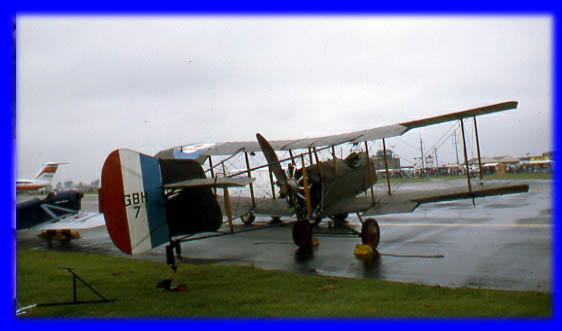 |
The Airco DH2 was the second design by
Geoffrey de Havilland. First flying in June 1915, it featured a
layout similar to the contemporary Vickers Gunbus: a pusher engine,
with the armament consisting of a Lewis gun! Power was provided by a
100hp Gnome rotary engine, which gave it a top speed of 93 miles per
hour. (Compare that with fighters of the second world war, just 25
years later, which were already pushing 400mph - the pace of
development over those 25 years eclipses anything before or since).
It was a single seater, grossing 1,440lb. it is 25 feet 2 inches
long, and has a wing span of 28 feet 3 inches. 400 were built.
This one was pictured at a wet Mildenhall in May
1987. |
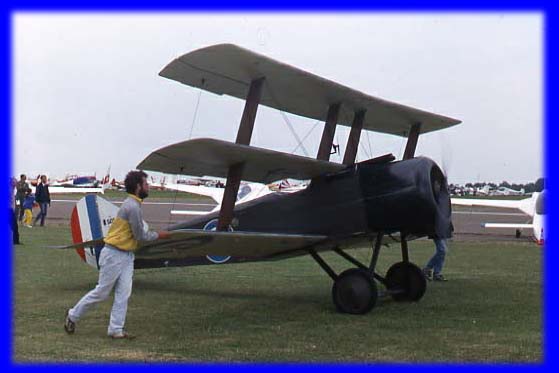 |
The Sopwith Triplane was one of the earliest
fighters used in the First World War. It was designed by the
legendary Thomas Sopwith, who lived to see the successors of the
company he founded producing the Harrier jump-jet. The first one was
delivered in June 1916 (to No 201 squadron) and was in action on the
day it arrived. Like many aircraft of its day, it was powered by a
rotary engine: where the crankshaft is stationary and the cylinders,
and the propeller, rotate round it. This makes it difficult to start
and adjust, and uses a lot of oil, but the momentum of the whirling
engine helps keep it going. The idea of the three wings was to make
it more agile in dogfights. It was able to reach 117mph, respectable
for its day, and could get up to 20,000 feet (but must have taken
ages to do so!).
This one is an accurate replica, seen at
Cranfield, date unknown. |
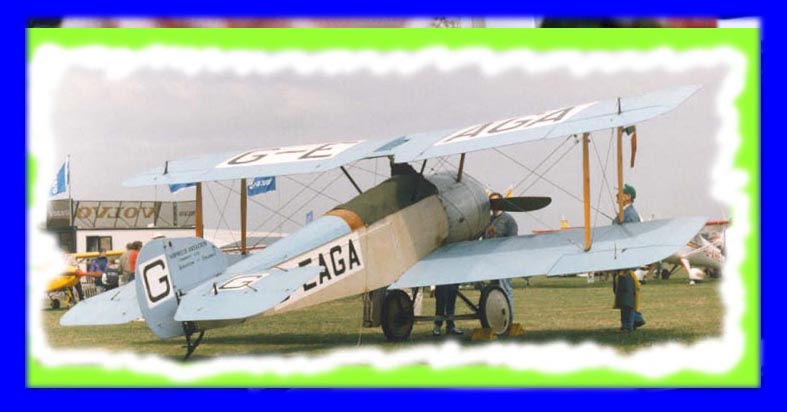 |
The Sopwith Pup first went into action with
54 Squadron in France in December 1916. It was a highly capable
fighter and, skilfully flown, could match the German Albatross D.5,
then the state of the art. Its armament was a single 0.303 inch
machine gun, but some versions could be armed with rockets mounted
on the wing struts! It could manage 110mph on its Le Rhone rotary
engine. This one is actually a
reconstruction of a Sopwith Dove, a two seat civilianised version
converted after the war in 1919 and seen at Cranfield. |
|
|
The Bristol Fighter represented the next
generation of aircraft after the early Rotary powered examples. It
was powered by a Rolls-Royce kestrel inline engine, which gave it a
top speed of 123mph. It was initially flown as a two seater,
entering service as such in June 1917. Early losses led to
experiments with operating it with only one person, which were
successful, and the `Brisfit' went on to become one of the most
successful aircraft of the first world war. It was one of the first
aircraft to feature a synchronised machine gun firing through the
propeller arc for greater aiming accuracy. This is an original Bristol F2B, kept in
flying condition by the Shuttleworth Collection at Old Warden, where
it was seen in 1991. |
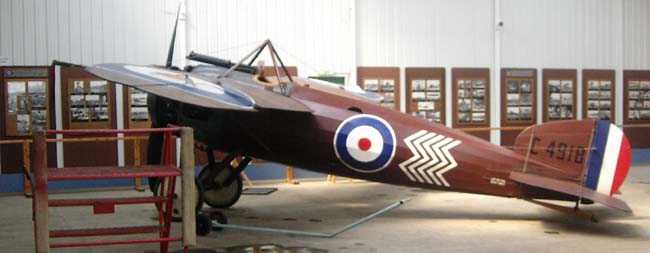 |
The Bristol M1C monoplane scout was one of
the few monoplanes to be used by the British forces in the first
world war. First flown in July 1916, it incorporated a number of
advanced features including a gun synchronised to fire through the
propeller arc, so in theory it would hit whatever the aeroplane was
pointing at. Its 110hp Le Rhone engine gave it a top speed of
130mph, and a gross weight of 1,350lb. It is only 20 feet 4 inches
long, with a wing span of 30 feet 9 inches. Despite its sound design
and respectable performance, only 130 were built.
Photograph by Ivy at Old Warden in April 2005. |
|
|
The SE5A was made by the Royal Aircraft
Factory during the first world war. First delivered in March 1917,
they were a potent addition to British fighter forces. Powered by a
Hispano-Suiza inline engine of 200hp, it could reach speeds of
130mph. Uniquely for a single seater of the period, it had two
machine guns: one on the fuselage firing through the propeller arc,
and one above the wing. This one was
flying at the Biggin Hill air display in May 1984. Lower photograph
at Old Warden in April 2005, by Ivy. |
|
|
The Hawker Hind was one of a series of
elegant biplane fighters made between the wars by the Hawker
company, founded by Harry Hawker to take over the design capability
of the Sopwith company after it went bankrupt in the 1920s. Other
types in the series, all of similar general layout, included the
Hart, Fury and Demon. Powered by a 640hp Rolls-Royce Kestrel inline
engine, it was capable of 185mph and was armed with a mixture of
machine guns and bombs.
Hinds were mainly made for export, this one
having served with the Afghan air force until it returned to Britain
in the 1970s for restoration. Today it flies with the Shuttleworth
Collection at Old Warden, where it was pictured in 1991. Lower
picture by Ivy in April 2005. |
 |
The Gloster Gladiator was the last of
Britain's biplane fighters. They entered service in March 1937, and
production ended three years later after 209 had been built. They
were powered by the Bristol Mercury radial engine (same as the
Bristol Blenheim bomber) and could reach 250mph - very respectable
for a biplane. Armament was four Browning .303 machine guns. The
most famous action they took part in was when four Gladiators from
Malta helped see off an attempted German invasion, as a result of
which the island of Malta was collectively awarded the Victoria
Cross - Britain's highest military medal.
This is the last airworthy Gladiator, and is kept
at Old Warden, where it was photographed in April 1981. |
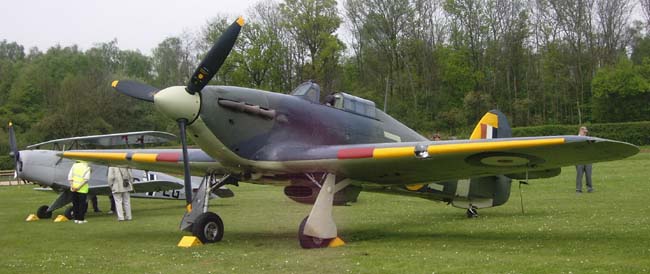 |
Of all British aircraft, the Hawker Hurricane is second only to the
Spitfire in terms of numbers built, with 14,074 having been
completed by the end of the second world war. First of the new
generation of monoplane fighters, it used similar design principles
to the earlier Hart series, so resulted in a less flexible airframe
than the Spitfire. It first flew in November 1935, powered by the
same Rolls-Royce Merlin twelve cylinder inline as the Spitfire. Top
speed was 340mph and it was initially armed with twelve 0.303
Browning machine guns. Being in production earlier, more were in
service at the time of the Battle of Britain, so they claimed more
enemy machines shot down than any other aircraft in that conflict.
Fewer Hurricanes survive than Spitfires. This
one was at Old Warden in April 2005. Picture by Ivy. |
|
|
The Supermarine Spitfire is probably the most
famous fighter aircraft in history. It was designed as a private
venture by the Supermarine company, which until then had specialised
in ungainly flying boats and one-off racing seaplanes. Designed by
Reginald Mitchell, it first flew in March 1936, and was at once
recognised as setting an entirely new standard for fighter aircraft.
It was powered by a Rolls-Royce Merlin engine, initially of 1,000hp,
giving a top speed of 350mph. In later versions the power rose to
over 2,000hp and the top speed to 460mph (mark 19, a photographic
reconnaisance version). Aerodynamic efficiency was ensured by the
aesthetically pleasing elliptical wing shape. Spitfires could be
armed with a mixture of machine guns and cannon, and could also be
fitted with a small bomb load for ground attack missions. More than
20,000 of all versions were built. The
top picture is of a Spitfire mark 1 flying at Bournemouth in August
1984. The lower picture shows a Griffon engined PR19 high altitude
photographic reconnaisance version, at Cranfield in July 1988. |
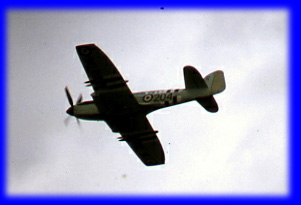 |
The Fairey Firefly was a high performance
fighter designed to be operated from aircraft carriers by the Royal
Navy. it first flew in December 1941. Powered by a Rolls-Royce
Griffon inline engine of up to 2,000 hp, it reached top speeds of
320 mph. It had a crew of two, unusual for a fighter of the period
but probably because of the greater difficulty of navigation when
trying to find an aircraft carrier in the middle of the ocean.
Armament was four 20mm cannon. The large radiators in the inboard
wing leading edge can just be seen in this poor picture of a Firefly
in flight at Abingdon in August 1985. |
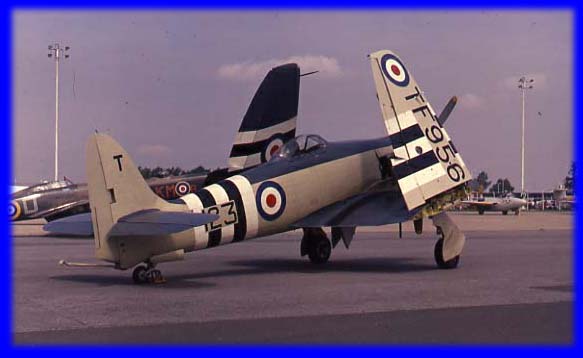 |
The Hawker Sea Fury was the last in the line
of punchy Hawker fighters which included the land based Typhoon and
Tempest. It was designed to be operated from aircraft carriers as a
replacement for the much slower Firefly; the Sea Fury raised the
speed to 430 mph, excellent for a piston-engined aircraft. They
entered service just too late for the second world war, but served
with distinction in the Korean war in the 1950s. By that time, jets
were beginning to dominate the fighter scene, but several MiG15s
still fell victim to the `old technology' Sea Fury.
This one was seen at Finningley in 1976. |





|